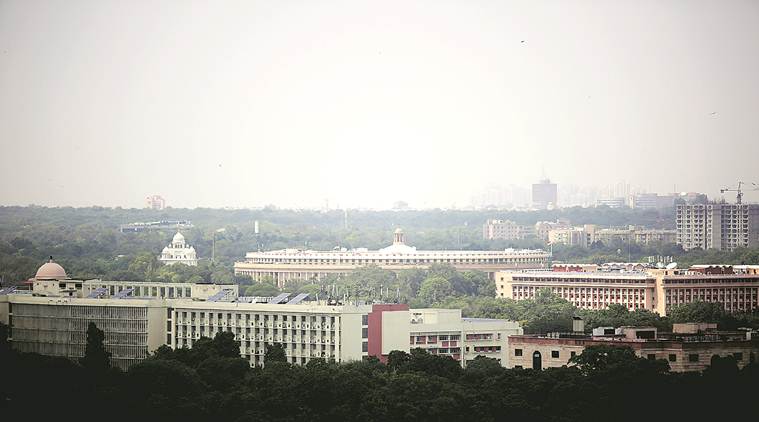 Buildings will be made earthquake-resistant. (Express photo by Praveen Khanna)
Buildings will be made earthquake-resistant. (Express photo by Praveen Khanna)
Taimur (1398) and Nadir Shah (1739) carried away camel-loads of treasures from the courts of Delhi to Samarkand and Isfahan. We will be reliving a modern version of those journeys quite soon. Nine miles of shelves of priceless documents, roomfuls of art treasures, and more miles of books, all now housed in the National Archives, and the Indira Gandhi National Centre for the Arts will be waiting for the camels or trucks to transport them. But to where?
The plan for the proposed new-look Central Vista is like a kaleidoscope. Every other day there is some modification. The proposed building-blocks numbered 10, then nine. That happened when it was pointed out that the main building of the archives was built in the 1920s and hence had the immunity of a “heritage” building. Like a lego piece, it was put back in, no matter that it will be enclaved by seven-storey buildings with three basements.
What seems undisputed is that the market for Vitamin D will shoot up. People working in the offices will travel from one block to another through tunnels. This, we are told, will reduce the traffic. Equally, no more will tired officers sing “Under the jamun tree/ Who will play cards with me?” We are not even sure what the fate of the jamun trees will be.
Coming back to my question. Where will our grandchildren go to see the National Museum, or what is left of it? There is a rumour that the IGNCA holdings are going to be shifted to Janpath Hotel. With the memory of the Akbar Hotel’s reincarnation, first as a ministry of the Central government, and then as a university, such suggestions do not surprise. But, anybody in the business will tell you that libraries and museum holdings do not take kindly to relocation. Two journeys — that of the archives library from Kolkata to Delhi in 1937, and of the Archaeological Survey’s library to the second floor of the Archives in the 1980s — are sad reminders. Many books and prints mysteriously disappeared in transit. And it does not help any that the National Museum has for years firmly resisted any attempt to have an inventory prepared.
In this digital age, do we need to build for humungous ministries? When post-offices and banks are down-sizing, why not ministries ? Is it at all possible to make our civil servants virtual? Plans for 10 seven-storey buildings to house all the staff of the government suggest a monotonous landscape.
In assessing an architect’s work, some details are often glossed over. There was a major set of buildings planned by Lutyens which did not get executed. His plan of 1913 included a cultural ensemble at the Queensway/Janpath crossing. Four complexes were to be built — the Imperial Record Office, the Antiquities Museum, an Ethnological Museum and the Imperial Library. The first was built in the 1920s; the Museum had to wait till 1960, the third was not assembled, and Curzon’s Imperial Library has remained in Kolkata as the National Library.
Some five decades ago, Delhi used to be dismissed as a city of bureaucrats and shopkeepers, with no culture. Over time, this void has been filled. The National Archives, Nehru Memorial Museum and Library and IGNCA (together with the excellent Central Secretariat library) have become part of its intellectual and cultural face — exuding the sense of scholars working in the cool tranquillity of the Archives, of school-children in animated chatter wandering through museum galleries, and of citizens relating to a welcoming public space in IGNCA. The Janpath crossing has a comfortable relationship with the city, celebrated through their outreach activities like the Rekhta Festival or visiting exhibitions. These have softened the landscape which otherwise would have been redolent of the musty smell of files and as full of endless corridors as “Last Year at Marienbad”. The Mandi House Culture Circle, the Lodi Road intersection, and the Humayun’s Tomb-Sundar Nursery complex, are three other major culture-nodes. These are achievements of the first half-century of Delhi as independent India’s capital. Destroy one, and the rest will feel a sense of insecurity. And what are they to be replaced by ? A wasteland of blocks of ministries at Rajpath, a convention centre at what was Pragati Maidan.
Redesigning a building in order to add or modify its contents is one thing. To demolish institutions and substitute offices which have no outreach function is another. A lack of respect for our past will create a cultural crater as deep as the new buildings are high.
The writer is a historian of Delhi